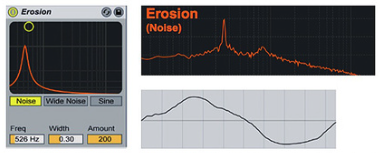Harnessing Creative Sound Design with Ableton's Erosion Effect
Introduction
Music production has come a long way since the days of analog tape machines and massive studio gear. Today, digital audio workstations (DAWs) like Ableton Live offer a plethora of creative tools to sculpt, shape, and transform sound. One such tool that often flies under the radar is the "Erosion" audio effect in Ableton Live. Erosion is a versatile audio effect that, when used effectively, can add character, texture, and uniqueness to your tracks. In this blog post, we'll explore the Erosion effect in-depth, understand its parameters, and discover the best ways to use it to enhance your music production.
Chapter 1: Unraveling the Erosion Effect
1.1 What is Erosion?
Erosion is an audio effect native to Ableton Live. It's a simple yet powerful tool that simulates the degradation of audio signals, creating a variety of textures and timbres that can add depth and character to your music.
1.2 The Parameters
Erosion offers three main parameters:
Type: Erosion has two types: Noise and Sine. Noise adds a gritty, rough texture to your audio, while Sine imparts a more harmonic and tonal character.
Frequency: This parameter controls the rate at which the audio is modulated. Higher frequencies create a more pronounced effect, while lower frequencies yield subtler results.
Amount: Amount controls the intensity of the erosion effect. Cranking it up can lead to more drastic sonic transformations.
Chapter 2: Adding Texture and Character
2.1 Adding Lo-fi Charm
Erosion can be a great tool for creating a lo-fi or vintage aesthetic in your tracks. By setting the Type to Noise and adjusting the Frequency and Amount parameters, you can introduce a layer of hiss and crackle that emulates the sound of old vinyl records or tape machines.
2.2 Emulating Vinyl Record Scratches
To achieve a vinyl-like scratching effect, you can automate the Amount parameter, gradually increasing and decreasing it over time. This approach adds dynamic texture, giving the impression of a needle traversing a worn-out record.
Chapter 3: Creating Unique Percussion
3.1 Experimental Drum Sounds
Erosion can be a secret weapon for sound designers and electronic music producers looking to craft unique percussion sounds. By applying Erosion to a drum sample, you can radically transform the sound. Try using the Sine type with a moderate Amount setting to introduce tonal variations and create unconventional percussion hits.
3.2 Hi-Hats with Character
Erosion can also be used to make hi-hats and cymbals sound more organic and textured. By using the Noise type with a relatively high Frequency and moderate Amount, you can add subtle grit and complexity to these elements, making them less sterile and more interesting.
Chapter 4: Sound Design and Synthesis
4.1 Transforming Synth Pads
Erosion can bring new life to synth pads, giving them an otherworldly and ethereal quality. By applying Erosion with the Sine type to a pad sound, you can create evolving textures and timbres that add depth and movement to your composition.
4.2 Creating Evolving Soundscapes
When designing atmospheric soundscapes or evolving textures, Erosion can be used to add subtle, shifting textures. Automating the Frequency and Amount parameters over time can create captivating sonic landscapes that evolve and change throughout your track.
Chapter 5: Layering and Processing
5.1 Layering for Depth
Erosion is a fantastic tool for layering sounds to create depth. Whether it's a vocal, a lead synth, or any other element, applying Erosion with a subtle touch can help the element sit better in the mix and make it more interesting.
5.2 Post-processing and Effects
Combining Erosion with other effects in your signal chain can lead to even more unique results. Experiment with effects like reverb, delay, and distortion to further shape the sound and take it in unexpected directions.
Chapter 6: Creative Automation
6.1 Dynamic Sound Sculpting
Automation is a powerful technique in music production, and Erosion is no exception. Automating the Frequency and Amount parameters can create dynamic, evolving textures that add excitement and variation to your tracks.
6.2 Transitions and Builds
Use Erosion to create transitional effects in your music. Automating Erosion parameters during build-ups or breakdowns can add tension and excitement to your composition.
Chapter 7: Collaboration with Other Effects
7.1 Combining with Filters
Pairing Erosion with filter effects can lead to some captivating sonic explorations. Experiment with high-pass and low-pass filters to shape the frequency content and emphasize certain aspects of the erosion effect.
7.2 Creative Sidechaining
Use sidechain compression in conjunction with Erosion to create rhythmic textures and interesting interplay between elements in your mix.
Chapter 8: Tips and Best Practices
8.1 Start with Subtlety
When using Erosion, it's often best to start with subtle settings and gradually increase the effect until you achieve the desired result. Extreme settings can easily overpower a mix.
8.2 Experiment and Explore
Don't be afraid to experiment with Erosion. Try applying it to a wide range of sounds and see where it takes you. Some of the most interesting and unique sounds in music production come from unexpected experimentation.
8.3 Save Your Presets
If you stumble upon a particularly exciting Erosion effect setting, save it as a preset. This way, you can quickly recall your favorite textures and timbres in future productions.
Conclusion
Ableton's Erosion effect may seem unassuming at first, but it's a versatile tool that can add depth, character, and texture to your music. Whether you're creating lo-fi atmospheres, unique percussion, or evolving soundscapes, Erosion offers endless possibilities for sound design. By understanding its parameters and experimenting with automation and creative effects, you can unlock a world of sonic potential in your music production. So, don't hesitate to dive into the world of Erosion and let your creativity run wild as you explore the depths of audio degradation.



